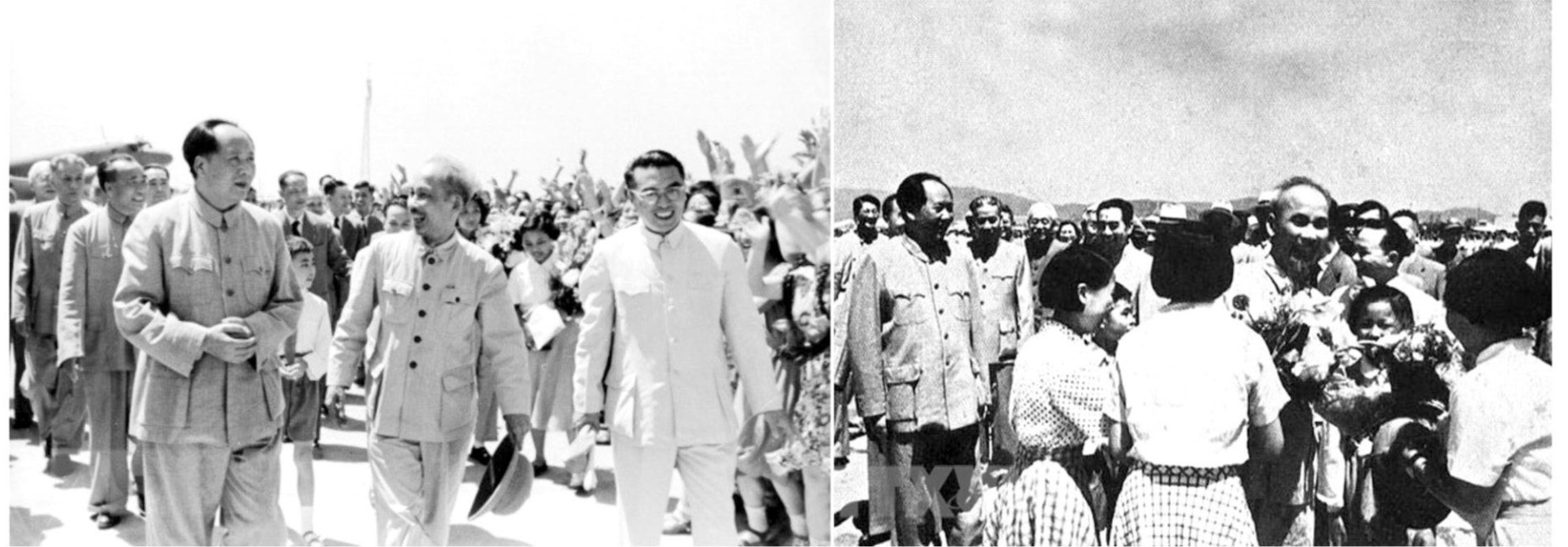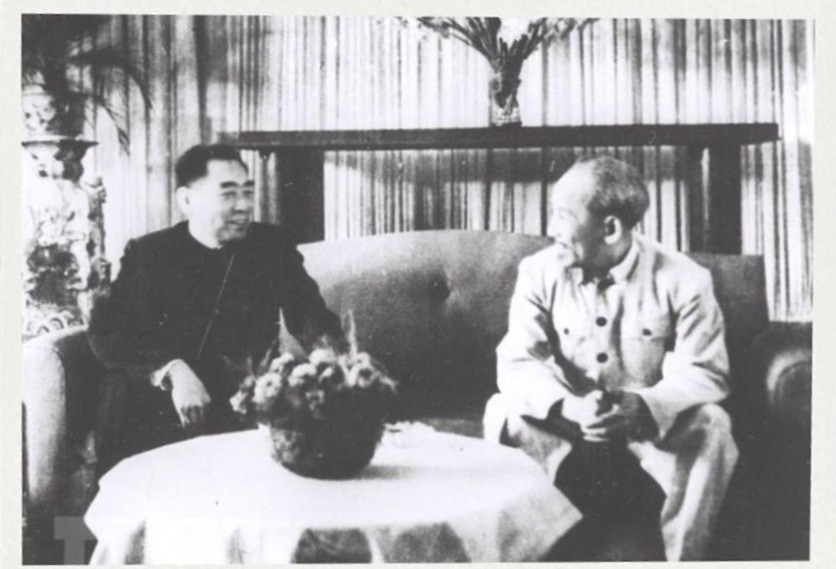As part of the series commemorating the 50th anniversary of national reunification, VietNamNet presents “April 30 - A new era,” sharing historical insights and lessons from the victory over the U.S.
The following article by Major, MA Le Minh Nam of the Institute for Strategic and Defense History Studies of Vietnam highlights China’s role in that struggle.

Left photo: Chinese President Mao Zedong welcomes President Ho Chi Minh on a friendship visit to China at Beijing Airport, June 25, 1955. Photo: VNA
Right photo: Chinese citizens welcome the Vietnamese Government delegation led by President Ho Chi Minh on a friendship visit to China, June 1955. Photo: VNA
With deep understanding and a sincere, close relationship with China, President Ho Chi Minh firmly declared: “Every plot by U.S. imperialists to divide Vietnam and China, and split socialist countries, will end in disastrous failure.”
Throughout the journey of leading the national liberation movement, the Vietnamese Party and State maintained an independent and self-reliant policy while consistently seeking international solidarity and support, particularly from the Soviet Union and China.
This approach helped to consolidate strength in defeating American imperialist forces. By embracing international solidarity, China provided significant multifaceted support to Vietnam, contributing importantly to the victory in the resistance war against the United States.
From the early days of resistance against American imperialism, the Vietnam Workers’ Party (now the Communist Party of Vietnam), led by President Ho Chi Minh, recognized the Soviet Union and China as vital pillars in the struggle to liberate southern Vietnam and reunify the country.
Consequently, one of the Party’s key strategies was to maximize support and assistance from China in all aspects. At the 7th Central Committee Plenum in March 1955, the Party emphasized the policy to “continuously consolidate solidarity and friendship with the Soviet Union, China, and other socialist countries.”
Implementing this strategy, from 1956 to 1960, President Ho Chi Minh led delegations from the Democratic Republic of Vietnam on visits to socialist countries, including China.
These visits expressed Vietnam’s desire to strengthen friendship and cooperation, especially with the socialist bloc led by the Soviet Union and China.

President Ho Chi Minh receives Premier Zhou Enlai on a visit to Vietnam, November 1956. Photo: VNA
With deep insight and genuine relations with China, President Ho Chi Minh stated: “All plots by U.S. imperialists to divide Vietnam and China and to divide socialist countries will end in disastrous failure.”
While seeking international support, the Vietnamese Party and State remained steadfast in their independence and national strength.
Their position was to make the socialist countries, especially the Soviet Union and China, understand Vietnam’s strategic determination, capacity for victory, and tactical approaches.
This understanding would foster support for Vietnam’s military, political, and diplomatic struggle and provide material assistance and effective coordination, particularly in the diplomatic arena.
Vietnam always valued China’s international role and the long-standing traditional friendship between the two peoples. Vietnam also appreciated China’s contribution to the anti-American cause of the three Indochinese nations.
When discord arose between the Soviet Union and China, partially affecting Vietnam’s resistance war, the Vietnamese government remained tactful and neutral. It avoided public disputes and refrained from creating unnecessary misunderstandings.
With a diplomatic approach grounded in international realities, the Vietnamese Party and State minimized the negative impacts of Soviet-Chinese tensions. They gradually gained China’s support for Vietnam’s strategic objectives and resistance goals.
China’s aid during Vietnam’s war against the U.S. mainly included infantry weapons, military supplies, uniforms, food, medicine, fuel, transport vehicles, artillery, and military equipment.
Between 1955 and 1975, China provided Vietnam with 1,594,724 tons of military aid. This included 2,227,677 infantry guns, 43,584 anti-tank guns, 24,134 mortars of various types, 290 rocket launchers, 1,376 field guns, 3,229 anti-aircraft guns, one regiment equipped with Hongqi missiles, 480 K6810 missile rounds, 142 fighter aircraft, 30 naval warships, 127 naval transport vessels, 552 tanks, 360 armored vehicles, 322 artillery tractors, 6,524 specialized vehicles, 15 pontoon bridges, 3,430 construction machines, 11 oil pipelines, and 36 complete equipment sets.
Beyond boosting Vietnam’s military strength, China also provided economic assistance through non-refundable aid and long-term loans totaling 2.872 billion rubles. These supported the import of key goods such as 40% of Vietnam’s steel, 34% of its liquid fuel, 35% of its fertilizer, 10% of its tractors, 62% of its grain, 87% of its cotton and yarn, and nearly all of its coking coal, metallurgical coal, and rail transport equipment.

Right photo: President Ho Chi Minh and President Mao Zedong toast to everlasting Vietnam-China friendship, August 1957. Photo: VNA
From 1954 to 1964, China sent 5,837 experts to Vietnam across various sectors. Between June 1965 and September 1966, China sent engineering troops to Vietnam’s northeast islands to construct defensive fortifications on 13 islands (including Co To, Cao Thau Chay, Thanh Lan, Do La, Phuong Hoang, Cat Ba, Quan Lan, Ba Mun, Van Hoa, Hon Doan, Phao Trong, Vung Ha, and Hon Met) and at eight strategic points including Do Son, Bieu Nghi, Dong Dang, Bai Chay, Trai Cai, Hon Gai, Cua Ong, and Tien Yen.
Between 1965 and 1968, China dispatched 346 experts and 310,011 troops to Vietnam, including anti-aircraft units, engineering, and railway and road builders. Chinese troops participated in 1,659 combat engagements, reportedly shooting down 126 aircraft (China's own tally listed 1,068 aircraft), with 771 personnel killed and 1,675 wounded.
At Vietnam’s request, in mid-1972, China sent personnel and equipment to help clear mines and bombs dropped by the enemy on rivers and at sea. China also supported Vietnam in other areas such as training, force development, logistics, and transportation. With the help of Chinese troops, transportation routes were secured, and the railway network in northern Vietnam was upgraded, strengthening the northern rear to support the southern front in the anti-American resistance.
While receiving China’s support, the Vietnam Workers’ Party led the nation in promoting self-reliance, gradually transforming international aid into internal strength. This ensured the steady advancement of the resistance and culminated in the decisive victory of Spring 1975.
With a clear and consistent resistance policy of independence, autonomy, and international solidarity, Vietnam successfully combined national strength with the spirit of the times. This secured broad and timely support from revolutionary and progressive forces worldwide, especially the Soviet Union and China.
Overall, during the harsh years of the resistance war against the United States, Vietnam received timely and substantial support from the Chinese Party, government, and people. This assistance significantly contributed to the swift and decisive victory of Vietnam’s people.
Major Le Minh Nam